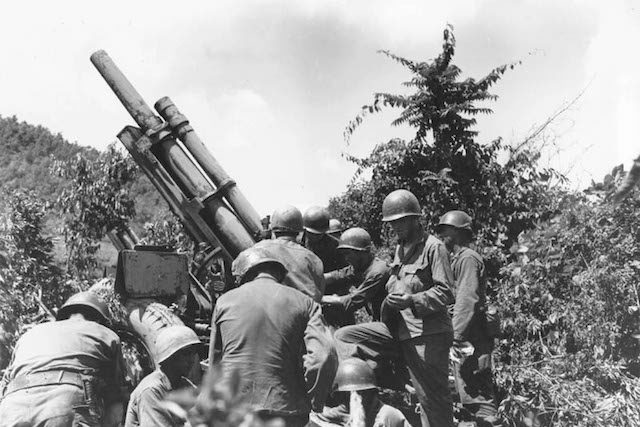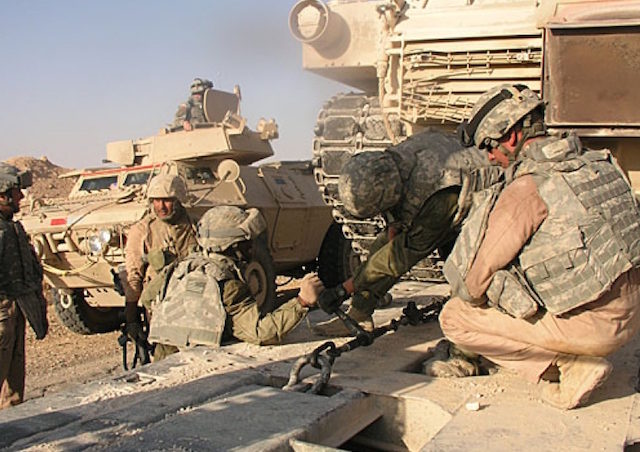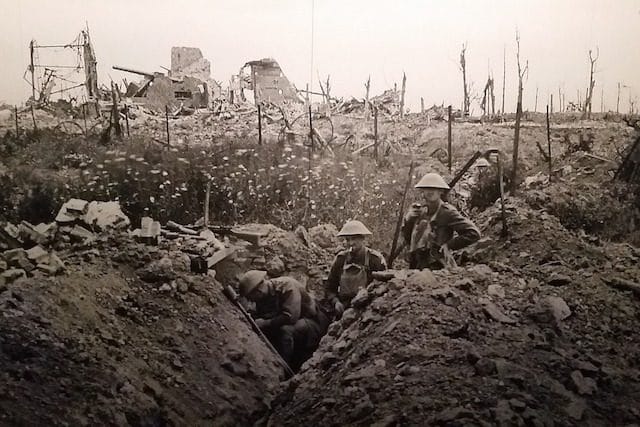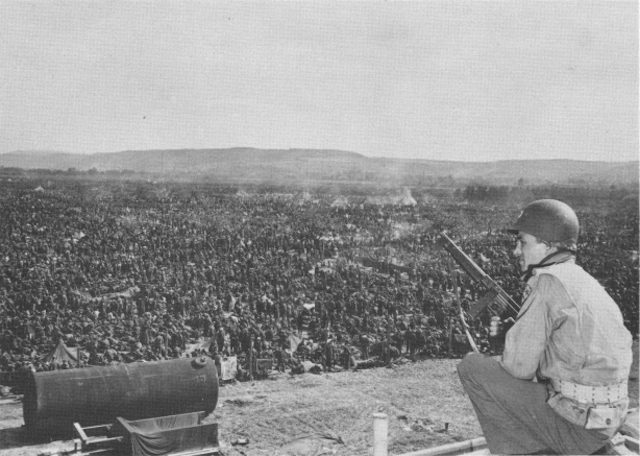War doesn’t come cheap. People complain about the budget allocated for defense all the time because the numbers are astronomical. It costs millions of dollars just to make a single nuclear warhead, and countries like the US and Russia have hundreds.
It seems crass to discuss the financial cost of a war when lives are on the line and, of course, we wouldn’t dream of diminishing the loss of life, which is the true tragedy of any war. But it’s worth noting the lengths that humanity goes to, and the money we have sunk into these terrible endeavors throughout history.
10. Second Sino-Japanese War: $1.3 Billion adjusted

Most of the costliest wars in history involved the United States, but not all of them. One of the biggest modern wars was the Second Sino-Japanese War, which took place from 1937 to 1945, coinciding with WWII. This was part of what made World War II a true world war, but it’s often left out of Western history books because it didn’t involve the Allied Forces directly.
The Sino-Japanese War was chiefly between China and Japan. At the height of the war, Japan was spending 7,713,150,000 yen per month. Now, obviously, this takes a little figuring to get the math right on, as well as adjusting for inflation. The end result is somewhere between about $413 million and $1.3 billion per month. The reason the range is so big is that finding an inflation calculator for a WWII era yen is pretty much non-existent. If you convert the yen to USD and then adjust for inflation, you get $1.3 billion. If you adjust for inflation and then convert to USD, you have to use numbers from the mid-1950s, so you’re off by at least a decade.
Suffice it to say, the war cost a small fortune, and it lasted for eight years. That means Japan was spending upwards of $39 billion, at the very least, to somewhere beyond $100 billion.
9. American Civil War: $87 Billion Adjusted

The US was already in debt by the time the Civil War started. A modest $64.8 million back in 1861. By the end of the war, it had added around $5.2 billion. When you tweak that for inflation, it tops out around $87 billion dollars.
The government passed the Legal Tender Act in 1862 to help fund the war. This included selling $500 million in bonds and also producing paper money in the form of greenbacks. These were the first paper bills that weren’t backed by gold. Essentially, they were just IOUs from the government, and they could pay for anything from groceries to taxes with the understanding that, at the end of the day, it was on the government to make good on any money they represented.
Other figures place the cost of the war at around $7 billion. This figures in both the costs of war in general as well as loss of life. Placing a value on life is a little shady at the best of times, of course. By these figures, the north spent about $139 per capita, which was just under a year’s GDP per capita. Down south, the cost was around triple that.
8. Korean War: $308 Billion Adjusted

It may have been the source of comedy in the form of the book, movie, and TV show M*A*S*H, but the price tag of the Korean War was no joke. When it ended in 1953, the total cost was tallied at around $30 billion. Adjusted for inflation, that works out to over $308 billion.
It also cost three years and 36,000 American lives, as well as over one million South Korean civilians and 200,000 North Korean civilians.
7. Vietnam: $1 Trillion Adjusted

Though the war started in 1959, the US became involved in Vietnam in 1965 and stayed there until 1973. Over the course of those eight years, over $168 billion was spent including $28.5 billion that was given as aid to the people of Southern Vietnam. That’s just over a trillion if you adjust the inflation right to the end of the war. It’s about $1.25 trillion if you take it from 1969.
Amazingly, the cost of the Vietnam War is still an ongoing expense. Veterans and their families are being compensated at an annual rate of $22 billion. Since 1970, the benefits have totalled about $270 billion.
Veterans of Vietnam were entitled to benefits, as were spouses if their partner died of causes related to the war. Their children received benefits until adulthood as well. Thanks to issues related to PTSD, something which wasn’t treated prior to Vietnam, as well as exposure to Agent Orange and a number of other diseases the government will be paying benefits to veterans who put their lives on the line for some years to come.
6. Iraq War: $1.9 Trillion

The US was engaged in the war in Iraq from 2003 until 2011. Troops have stayed in the country pretty much non-stop since the so-called end of the war as well. The total price tag has been figured at $1.9 trillion. This figure covers a wide array of expenses. As with most, the bulk goes to the everyday expenses of war. Soldiers on the ground and the equipment they use. But a lot of that money was essentially just stolen.
Money for contractors was misappropriated in both Iraq and Afghanistan. In fact, it’s been estimated that as much as one third of money allocated for contracting is spent on fraudulent claims. That’s essentially contractors overbilling the government to line their own pockets. Between Iraq and Afghanistan, that worked out to between $31 billion and $60 billion. A total of $138 billion went to contractors, valid or otherwise.
5. War in Afghanistan: $300 Million Per Day

The war in Afghanistan is one of those wars that seems to have always been going on. Is it officially over now? Maybe. But it lasted for over two decades and the region is by no means stable, so no need to declare mission accomplished just yet. That said, the price tag for whatever was accomplished is steep and unsatisfying. Figures vary now and then, but the general consensus is that the total price has been around $2.3 trillion. That works out to around $300 million every day for years.
The breakdown of how that money was spent is not an easy read. A total of $800 billion went to direct costs, things like salaries for soldiers and equipment. Another $85 billion was spent to train the Afghan army. The Taliban swept through the country and defeated that army in just days. Another $750 million went to paying salaries for the Afghan army. Other costs include money spent to help injured veterans as well as interest on all the money being spent in the first place.
4. War of 1812: $2.8 Trillion Adjusted

One of the earliest wars in American history, the War of 1812 proved to be a financial debacle for the ages and one that took nearly 20 years to pay off. By the end of the war the government was into it for $158 million. Upwards of $90 million of that went to paying for the Army and the Navy. When you adjust for inflation that’s about $2.8 trillion sunk into the endeavor.
By 1814, the government was bankrupt. They had defaulted on numerous loans and were not able to maintain regular expenses. Pay for soldiers were arrears for up to a year. The government had to offer soldiers land in exchange for service, promising up to 320 acres for any soldier who stuck it out to the end of the war, despite the lack of paychecks.
Private millionaires actually paid off a bulk of the debt the government had incurred over the course of the war, with David Parish, Stephen Girard, and John Jacob Astor together putting up nearly $16 million to help the country out. That’s about a quarter of a billion in today’s dollars.
3. WW1 – $3.3 Trillion Adjusted

Although not as costly as WWII, the First World War kicked the world in its collective bank account and took all the pennies that fell out. At the time, the cost of the war was somewhere between $185 billion and $208 billion, depending on your sources. But even if you go to the low end of that scale and account for inflation from 1918, you’re looking at a $3.3 trillion bill.
Germany dropped more money than any other nation, which is understandable. Their total in wartime dollars was over $37 billion, for a modern total of about $686 billion. The US made it through with just $414 billion invested while the Brits dropped $641 billion. Needless to say, when it came to finances, nobody won this war.
The effect of this on the German economy is well recorded and almost cartoonishly dumb. Parts of Germany experienced hyperinflation beyond reason. A loaf of bread famously cost $428 billion German marks. Marks were arguably worth less than the paper they were printed on. One US dollar was worth 4,210,500,000,000 marks. That’s 4.2 trillion. They had essentially destroyed their own economy to fund the war effort. Fixing this economic devastation was, in part, what paved the way for Hitler’s rise.
2. WWII: $4.7 Trillion Adjusted

It stands to reason that the biggest war any of us can think of was the most expensive, but the scope of this one is off the charts. Adjust for inflation, it’s assumed that the Second World War brought a price tag of $4.7 billion. In the final year of the war, the money spent was 40% of the United States total GDP.
Compared to today, this is far more than we spend on modern wars which are still cracking the trillion dollar mark. Part of that comes from the jaw-dropping scale of WWII. Today’s military may have 2.5 million members compared to WWI when 12.2 million were deployed.
That money went to things like 41 billion rounds of ammunition, 303,000 aircraft, 100,00 tanks and 27 aircraft carriers, among numerous other expenditures. To help cover the cost, taxes were boosted up to 94% in some cases. Imagine someone trying that today.
To help keep men in the military, privates were paid $50 a month. That’s paltry today, but in those times it was more than most salaried professionals made.
1. Cold War: $5.8 Trillion

Technically, the Second World War is the most expensive war ever fought. But the Cold War is still regarded as a war, even if troops never invaded anywhere for a big throw down. And with that in mind, it is hands down the winner, or loser, depending on perspective, of the most expensive war showdown.
Spanning from 1940 to 1996, if you add up how much money was spent on the nuclear arms race that was at the core of the Cold War conflict, America dropped a staggering $5.8 trillion. You can safely assume the Soviet government also dropped a hell of a lot on their end, despite the fact their numbers are hard to nail down. It’s probably a safe bet to guess that over $10 trillion was spent worldwide on the Cold War and the continued maintenance of nuclear arsenals.